
吃驚 BIKKURI
2010年10月23日(土)~11月21日(日)
津田 道子
TSUDA Michiko
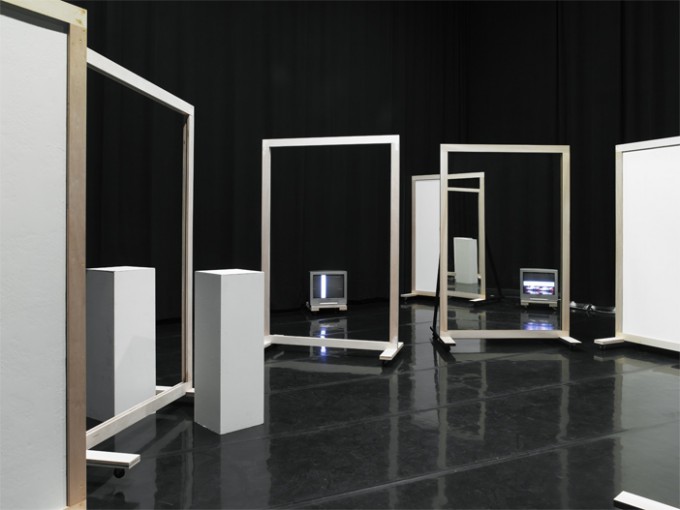
《配置の森の住人と王様》インスタレーション 撮影:山本糾
構造の庭としての映像空間
服部 浩之
津田道子は映像だからこそ生成可能な世界を探求し、空間・時間・行為をドキュメントする映像作家だ。津田は現実空間に鏡などを用いて小さな虚構の世界を同居させ、そこで遊戯するパフォーマーの振る舞いを通して、謎解きをするかのように空間を認知していく過程を詩的に記述していく。
ACACでは、ダークブラウンの厚めの額縁的なフレームで囲われたキャスター付きの2枚の「鏡」を発見したところから制作をスタートした。津田はその鏡と同じ大きさのやはりキャスター付きで自立するフレームを計4枚作成し、2枚はその中に白いボードを挿入し、残りの2枚はフレームだけのものとした。便宜的に前者を「壁」、後者を「フレーム」と呼ぶことにする。鏡に似せてつくられたこの壁とフレームは鏡の存在を曖昧にし、空間に予期せぬ広がりを持たせる重要な要素である。それらと展示用ボックスやテレビモニター、ビデオカメラなどを用いてギャラリー内に撮影用のセットをつくり、そのセット自体をインスタレーション(fig.1)として公開するとともに、セット内でパフォーマーが鏡、壁、フレームを移動させ様々な配置を試みながら空間を変容させていくパフォーマンスを撮影し、インスタレーションの奥に設置した独立した上映室で映像作品(fig.2)として公開した。
インスタレーションとして提示された公開制作の現場でもあるスタジオセットでは、別々の位置に設置された2台のビデオカメラに接続された2台のモニターが、セットに迷い込んだ観客の身体を様々な角度から捉える。観客は離れた位置にあるモニターや鏡に写しだされる自身の複数の身体を同時に発見し、また自身が移動することにより鏡のなかに描写される世界が変化していく様子を観察する。それによって、このインスタレーションが実像と虚像としての鏡像が変化しながら共存するさまざまな空間を体感する認知ゲームのような場であることを認識し、映像世界について考える大きな足がかりを得る。そしてこの空間を抜けると上映室があり、このセットで記述された世界を客観的に鑑賞することができる。
≪配置の森の住人と王様≫というタイトルを分析すると、このセットが「配置の森」であり、パフォーマーなどセット内で遊戯する人々が「住人」、そして静かに豊かな空間の変容をとらえているカメラのファインダーをのぞくもの、あるいはその映像を鑑賞する観客が唯一絶対的な視点で空間を体験できる「王様」となると思われる。このタイトルからは、津田が完結した物語世界としての映像を生み出すタイプの作家ではなく、被写体、カメラ、撮影者、鑑賞者という映像が必然的に備える関係性や構造そのものについて探求していく視点をもっている作家であるということが明確に見えてくる。
滞在中に津田はこのセット内で計4種類の映像をそれぞれ異なったパフォーマーたちとつくっているのだが、ここでは展示作品として公開された映像作品≪配置の森の住人と王様―模様替え≫を主に取り上げて彼女の作品を解説していきたい。撮影方法は非常にシンプルで、真正面に1台ビデオカメラを固定し定点で撮影するのみである。カメラのファインダーは、キャスターによりスムーズに動く各2枚ずつの鏡・壁・フレームを、2人のパフォーマーが相互の動きを意識しながら静かに移動させていく様子を捉える。約8分の映像ではパフォーマーが鏡、壁、フレームの配置を模様替えしていく様子が淡々と静かに流れるのだが、しばしば予期せぬ場所が鏡に写り込んだり、フレームの奥の実空間と鏡の中の虚空間の差異が曖昧で認識しづらい瞬間が発生したりと、その映像のなかでさまざまに変化する空間構成は簡単には解明できない。
あるシーンでは、カメラに対して左手にフレームを30度程度の角度をつけて置きその手前と奥に同型の展示用ボックスを配置し、奥のボックスのすぐ後ろに女性のパフォーマーがフレーム内におさまるように立っている。そして画面右手にはやはり30度弱の角度をつけて配置された鏡が1枚あって、カメラのファインダーの外側に配置された壁の前に男性のパフォーマーが立ち、その壁とパフォーマーが鏡に写り込んでいるという状況(fig.3)がある。映像で見ると2人のパフォーマーは同じ画面内にどちらも実像として存在しているように見えるのだが、実際には男性のパフォーマーはカメラのファインダー(視界)の外側にいるという状況だ。女性は実像で、男性の方は虚像なのだが、カメラで写し取られた映像としてみると彼らはおなじ平面上に存在しているように見える。
また別のシーンでは、正面にフレームがカメラに対して正対して置かれ、すぐ奥にはそのフレームの内側におさまるように2枚の鏡が対称の角度で設置され、さらに奥に壁が正対で置かれている。フレームの両脇にはパフォーマーがひとりずつ立ち、フレーム側の手を延ばして動かしている。ここではふたりの手は鏡のうしろで動かされているため見えないはずなのだが、女性の手が男性側の鏡に映し出され、男性の手が女性側の鏡に映し出される。つながっているはずの空間が鏡により切断されて、全く別の空間が接続されている。一見男性の身体から女性の手が延びていて、女性の身体から男性の手がのびているように見えなくもない(fig.4)。これもふたりのパフォーマーの身体は実像なのだが、それぞれの手は虚像であり、映像としては実像と虚像が唐突に接続されるように、やはりひとつの世界に共存している。
ちなみに撮影前にパフォーマーは、鏡、壁、フレームを動かしながら、それらがつくりだす複雑な空間を把握していき、それに応じて彼らの動きを津田が振り付け、空間構成の物語を築いていく。津田は、彼女が準備した要素をパフォーマーが移動させ、庭づくりをするように様々な配置関係を発見していく過程を記録することによって、あるルールのもとで人が空間を把握していくゲームを楽しんでいるようにも見受けられる。
この空間を体験することにより実感したのは、鏡が2枚以上になった瞬間に、途端に空間の認知は難しくなるということだ。1枚の鏡はただ像を写しだすのみだが、2枚の鏡が関係し出すと鏡像による鏡像が出現することになり、配置によってはどこまでも像が反復していくとてつもない奥行きをもった空間が立ち現れてくるからだ(fig.5)。ただでさえ同じサイズのフレームや壁が並んでいて、それが鏡に映り込むので、実像と虚像の関係や空間の奥行きは一瞬では認識するのが困難なのだ。パフォーマーも意図しない状況で鏡に映り込んだ自分を発見したり、予測もしない位置に他者を見出したりと、さまざまな矛盾を内包したような空間構成を経験する。そしてその様子を静かに撮影する津田がその背後にいるのだ。
この魅力的な空間を探るための配置運動を繰り返し記録する反復行為は、パフォーマーのちょっとした動きのタイミングのずれや、鏡などの配置のほんの僅かな角度の違いが生み出す小さな差異により、意図していなかった状況をつくり出し、一回限りのさまざまな空間を生成していく。その状況をビデオカメラによって丁寧に記述していく津田の行為は、映像が持たざるをえない構造を探求しドキュメントしていく試みなのだ。
また、基本的に津田が撮影しているものはパフォーマーの振る舞いであり、その視点で捉えると彼女はパフォーマンスの記録映像を撮影しているとも言える。ただ、そのパフォーマンスは津田が設えたインスタレーションとしてのセット内で、実像と虚像が交わりつくり出すフィクショナルな空間を認知する行為としてのパフォーマンスである。つまり津田はパフォーマンスを記録することにより、映像だからこそ現れる時空間とその構造や奥行きを模索すべくドキュメント映像をつくっているといえるのであろう。
今後も映像技術は発展し続けるであろうし、その活用法や社会との関わり方もさらに多様になっていくと思われるが、そんななかで彼女がその根源となる映像の本質的な構造や技術的に備えてしまう性質をどのように咀嚼し作品としてドキュメントしていくのか、今後の展開に注目したい。
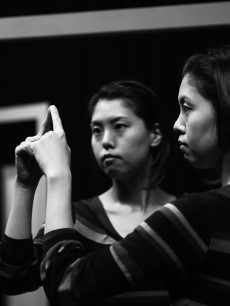
撮影:山本糾
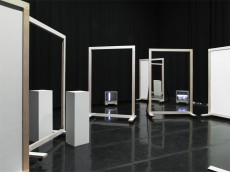
fig.1 《配置の森の住人と王様》インスタレーション、2010年。

fig.2 《配置の森の住人と王様―形式論理の不具合#01》映像、6分44秒、2010年。
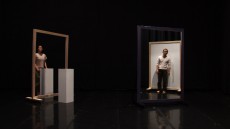
fig.3 《配置の森の住人と王様―模様替え》映像、8分5秒、2010年。

fig.4 《配置の森の住人と王様―模様替え》映像、8分5秒、2010年。

fig.5 《配置の森の住人と王様》インスタレーション、2010年。


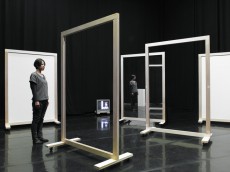

吃驚 BIKKURI
October 23 -- November 21, 2010.
TSUDA Michiko
津田 道子

Occupants and King in the Configuration Forest, installation. photo: YAMAMOTO Tadasu
Filmed Space as the Garden of Structure
HATTORI Hiroyuki
TSUDA Michiko is a video artist who explores a world that arises only in motion pictures and documents such space, time and movement. Making virtual spaces coexist with real spaces by using mirrors and other props, she poetically records the process of space perception like solving a puzzle through the movements of performers.
Tsuda started to work on the production at ACAC upon finding two identical mirror panels with dark brown frames and casters. She made 4 frames with casters similar to the mirrors; two of them were left as they were while the others were filled with white panels. The former are called the “frames” and the latter the “panels.” These mocked mirrors are important elements that obscure the presence of the real ones and unexpectedly expand the space in the video. The artist set up a “studio” for shooting that consisted of the real and mock mirrors, pedestals, TV monitors and video cameras in order to show the entire space as an installation (fig. 1) and to shoot the performances in which the performers moved the mirrors, panels and frames in various ways to change the appearances of the space. The video was screened in another room in the back of the installation (fig. 2).
In the studio set, which was also an open studio, the two video monitors displayed the spectators wandering in the space filmed by two video cameras from different angles. The spectators saw themselves appearing on both monitors at the same time and witnessed the changes in the world reflected in the mirrors as they walked. In doing so, they knew this work was like a game of space perception in which the real images and the virtual images in the mirrors coexist continuously changing and came to think about the space in video imagery. When they walk through the installation, they entered the viewing room and objectively watched the world recorded in the video.
As for the interpretation of the title of this work, Occupant and the King in a Configurating Forest, probably the studio set is a “configurating forest,” the performers who played in the set are the “occupant” and the artist behind the camera that quietly filmed the variable space and the spectators who watched the video from the only-one absolute viewpoint are the “King”. The title seems to indicate Tsuda seeks to explore the structure and the relationships that inevitably arise within any video image among the subjects, the camera, the photographer, and the viewers rather than to present a video as a self-sufficient narrative.
While Tsuda shot 4 videos featuring different performers during her residence, I would like to mainly discuss one of them that was presented in this exhibition, "Occupant and King in the Configurating Forest--Arrangement of a Room". The method of shooting was very simple: the artist fixed a camera in front and shot straightforward. Its finder captured the smooth movements of the pairs of mirrors, panels and frames the two performers silently operated corresponding each other. As the 8-minute video simply portrays how the performers changed the arrangement of these partitions, mirrors often reflected unexpected sections of the room, and the difference between the real view of the room across the frames and mirror reflections were sometimes obscure. It was not easy to exactly know how the structure of the room changed.
One scene shows a frame standing on the left hand side at an angle of 30 degrees, two pedestals on both sides of it, and behind these objects stands a female performer who appears fitted to one of the frames. On the right hand side is a mirror, also at an angle of 30 degrees, and the male performer standing in front of the panel outside the camera’s field of vision (fig. 3). While the woman is real, the man is a reflection, but both appear to be real as if standing side by side the same vertical plane in the video image.
In another scene, in front of the camera is one of the frames, and behind it are the two mirrors symmetrically placed face to face at the same angle. In the back center is one of the panels facing the camera. On both sides of the frame are the two performers, stretching and moving their arms that are closer to the frames. The arms cannot be seen because they are behind the mirrors but the mirror on the woman’s side reflects the man’s arm while the other one reflects the woman’s. The undivided space appears to be partitioned by mirrors and yet reconnected to another space. The woman’s hand looks as if sticking out of the male body and the man’s hand out of female body (fig. 4). As their bodies are real and their hands are reflections, the real and the virtual are abruptly joined and coexisting in the same world.
Prior to the shooting, the performers had moved these mirrors, panels and frames to study how their movements create the complex structure in the space. Then Tsuda choreographed and created a narrative about space arrangement. Recording the performers’ moving the props she had prepared to try various arrangements as if designing a garden, the artist seemed to enjoy playing a game of exploration in a space following certain rules.
What I learned in the space was that, when two mirrors were involved, it became immediately difficult to perceive the space structure. One mirror just reflected the objects around there but once the other one comes in, the mirrors reflects each others’ reflections so that the space appeared as if extending endlessly (fig. 5). There are also the frames and panels in the same shape and size and they are reflected in the mirrors as well so it is hard to tell at once the relationship between the real and the virtual, the true depth of the space. Performers experienced a space that contained various conflicts, unexpectedly finding themselves reflected in the mirrors and seeing each other standing in a surprising position. And behind them was the artist quietly filming.
The act of changing the arrangement of the attractive space led to various unexpected situations and created a variety in space arrangement that happened only then and there for a moment, caused by subtle differences between the two performers’ movements or the angles of the equipments’ positions. And Tsuda’s careful act of recording this event by video camera is an attempt to explore and document a structure that video imagery cannot evade.
Considering that Tsuda’s camera basically followed the performers’ behaviors all the time, the video is a record of the performance. However, the performance was choreographed by the artist and took place in a set installed by the artist as an attempt to perceive a fictional space where the real and the virtual are crossing each other. Thus, by recording the performance, Tsuda probably intended to document the temporal space and its variable structure and depth that emerge only in video imagery.
As video technology advances, the ways we make use of it and the ways it affects society will be varied. We are looking forward to seeing how Tsuda will digest and exploit its essential structures and inherent technical characteristics from now on.

photo: YAMAMOTO Tadasu

fig.1 Occupants and King in the Configuration Forest, installation, 2010.

fig.2 Occupants and King in the Configuration Forest--Defective Formal Logic #01,video, 6min44, 2010.

fig.3 Occupants and King in the Configuration Forest--Arrengement of a Room,video, 8min05, 2010.

fig.4 Occupants and King in the Configuration Forest--Arrengement of a Room,video, 8min05, 2010.

fig.1 Occupants and King in the Configuration Forest, installation, 2010.




